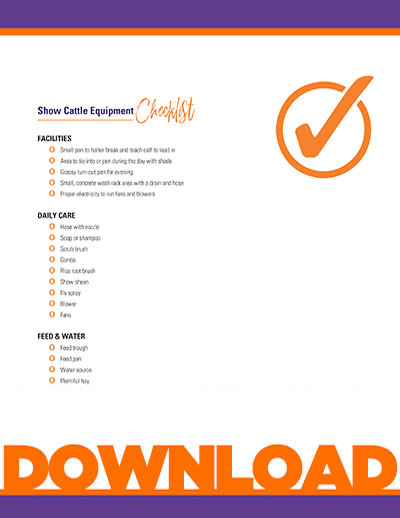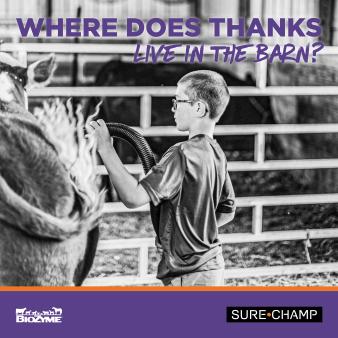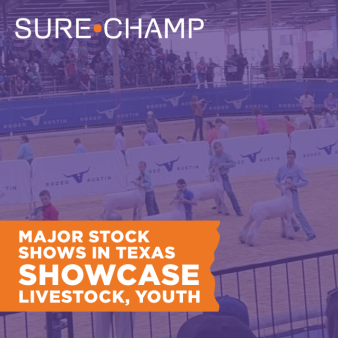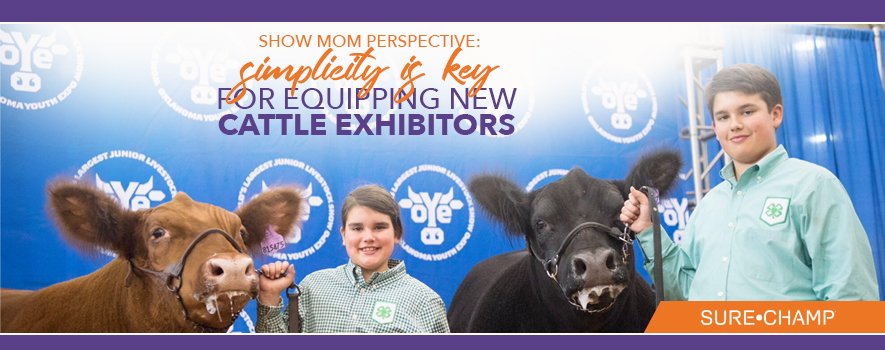
It takes a lot of time and practice to be successful at anything you want to succeed in, and for the Glover family of Elgin, Okla., raising and showing cattle is their “sport” of choice. Jamie and Dustin Glover run about 500 cows, working to raise top-quality show steer and heifer prospects to sell across the U.S. And, when they aren’t working with their herd, they can be found in the show barn helping their kids, son Tommy, 14, and daughter Taylor, 10, working on their next set of show prospects.
“We’ve been fortunate to be successful in the show ring,” Jamie said. “We do this as a family. I compare it to sports; you see families whose kids are really good at sports, and the reason they are really good is they work at it. They spend the extra time practicing, and I think the same thing is true in the show barn. That’s what we spend our spare time doing.”
Through the cattle industry, Jamie met her husband and is now teaching their children the sport of showing cattle. Through her years of experience, she has seen the business evolve from a time where only two different combs were available to a time where a person can get overwhelmed with the nearly two dozen options available today. However, she has one message for newer cattle exhibitors and their families, “keep it simple.”
“A person can spend a lot of money really fast. We try to be really conscious of this when helping families get started,” she said.
Jamie offers her advice to newer cattle exhibitors for the items they will need to have a successful first year of showing.
Facilities
Your facility needs will vary depending on the scenario of the calf you are buying. If you are purchasing a calf that is already broke to lead, your facility needs will be significantly different than if you need to halter break your calf once you get it home. If you do have to break your calf to lead you will also need to have a secure pen where the calf will not get loose, even if that means keeping it at the neighbor’s place for a few weeks or working with the seller to help you get it broke to lead before you bring it home.
“If you are going to have to break it to lead yourself, have a small secure area to start in so that your calf can’t get loose. Once they learn how to get loose then it’s sometimes hard to correct that behavior,” Jamie said.
If you have just one or two calves during your first year, it may not be feasible to build a barn with steel pens, but you will certainly want to have a place in the shade to keep your calf contained during the day and a turn-out pen for the evenings. Make sure the place you bring your calf to tie into or pen during the day is in a nice, clean and dry area in the shade with plenty of air movement. You’ll want to have fans on your calf to help keep it cool, especially during the heat of summer and in the more humid climate.
Jamie suggests having a turn-out pen for the calves to run in the evenings after you have worked them. The pen should be big enough to allow for exercise and have grass, a fresh water source, a small catch-pen to catch your calves in safely each morning or an alley connecting to your pen where the cattle will stall during the day.
“We pamper them and treat them like pets, but they need space to go out and be a calf, too,” she said.
Finally, in the barn, you will want to make sure you have some place to rinse and wash your calf. It is best not to wash in the mud if you can avoid it. Ideally you would have a pour a concrete area with a drain, so the cattle have a solid place to stand while getting washed and rinsed.
Around the Barn
On your wash rack you will want the standard items like a hose with a good nozzle, scrub brush and soap. Jamie said that most of the time they rely on Dawn dish soap.
“Sometimes if we need, we’ll invest in some moisturizing shampoo or whitening shampoo, but for someone getting started, I tell them to go to the dollar store and get some Dawn. As they become more familiar with their calf and his or her skin needs they can use moisturizing or whitening shampoos as needed. Cattle are like people, each calf’s skin and hair will have different needs,” she said.
Once you get them washed or rinsed, you will need a blower with ample electricity to dry your calf.
Other items on your supply list will include some combs, a rice root brush, show sheen and fly spray. Depending on your location you might need to spray for flies multiple times daily to keep your calf feeling good, which helps keep it on feed.
Feed and Water
Two things that are essential to your calf’s care are access to fresh water, and continual availability of fresh, good quality hay. There are about as many options for show feed as there are scotch combs. Consult with the person you bought your calf from, talk to a neighbor, FFA advisor or 4-H leader to find out which feed is available in your area and will be best for your project.
“My husband and I both grew up around this, so we are supposed to know this, but we still learn something new every day. So, talk to other people showing cattle and find out what’s working for them whether its feeding or showing or daily care. There are lots of wonderful people in this business who enjoy helping families learn,” Jamie said.
The Glover family likes to feed their animals in feed troughs about 18 inches off the ground, although a person could also feed from feed pans, if they have those. When it comes time to feed animals, Jamie said keeping the feed fresh is imperative. Even though many people have to drive a distance to pick up show feed and supplements and might like to stock up on feed, it is important to your animal’s health and performance to keep the feed fresh. Calculate how much feed you will need for a few weeks and try not to keep more than two-weeks’ worth of feed on hand.
Jamie said knowing exactly what your calf is eating is important, so you know how to gauge how close you are to reaching your end-point. She weighs all of her feed by scoop and then knows how many scoops of what feed to give each calf. For instance, one feed might only fit 2.5 pounds per scoop, where a denser feed like a pellet mike fit 4 pounds per scoop. Calculate what you feed each animal and know the “scoop” count. It is truly easier than weighing each feeding out, especially if you have multiple calves.
Also, it is important to develop a consistent routine for your cattle in terms of daily care and feeding times. This will help to ensure cattle remain on feed consistently. And finally, regularly monitor how your calf is gaining on the feed ration you are giving. Weigh every 2-4 weeks so you can monitor if the calf is gaining and help determine if you need to make feed adjustments.
Goin’ to the Show
Once you’ve worked with your animal and are ready to hit the show road, you’ll need specific supplies just for the show that gets packed into your trailer, or you might even keep them packed in your trailer, if space and the environment allow.
Jamie reminds that each family needs a set of divider panels or end panels to set up a stall for just your family’s calves. And if it is your first year, and you are unsure if this will be a forever project, she said to coordinate with a neighbor, 4-H club or FFA chapter because those groups might have extra that you can use.
Be sure to have access to a chute. You can often buy these used, and that will be good enough, but you will need access to a chute to clip and fit your animals at the show.
You will also want a rubber mat to put in your stall. The show supply companies do sell long mats, but for one calf Jamie suggests a smaller version, like a food service mat with holes in that you can buy at Lowe’s or Home Depot. This mat lets the bedding come up, but keeps the calf from pawing at the bedding, and doesn’t get slick.
The next thing you need is a show box. This is essential as you need a place to put your ‘stuff’ that you can lock up at night. And there are plenty of options available, according to Jamie.
“You can spend as much or as little money as you want on a show box. If it’s a smaller show, use a little roll-away tub. We’ve gone to Lowe’s or Home Depot to get one of those nice black boxes on wheels; or you can get nice Aluminum show boxes with trays. Don’t overthink the pressure of ‘what show box should I buy?’ Just find one that fits your needs functionally and financially,” she said.
Once you have your show box, it won’t take long to fill it. There are some items that can stay in there, because you will use them only at the show, such as a show harness, show halters, adhesives, paints, neck ropes, rubbing alcohol, mineral oil, and human supplies like ibuprofen, hair spray and a brush. She said they also keep their kids’ belts in the show box during show season and this way they aren’t left at a hotel on show morning; one more way to make show day efficient.
The Glover show box includes mineral oil, just in case of bloat. They also keep rubbing alcohol on hand to help clean end panels or the chute before clean animals touch them. Paper towels are essential for both the cattle and humans. Adhesives and paints are also important. But, be sure to check with the show rules to make sure they allow them, as some shows do not allow coloring agents.
“Most of the time you can buy your glues and paints when you get to the show. But be sure to pick up your cans afterward. Those products cost money, pick them up and keep them in your show box,” Jamie reminds.
Supplies you’ll want to bring from your barn at home to the show include your water hose, fork to scoop poop, show stick, feed pans, water buckets, hay, feed, fans, blowers, soap, brushes and combs.
When it comes to supplies for your show cattle project, the options are endless. Jamie said they like specific products from Weaver, just like they prefer other products from Sullivan’s.
“Everybody’s role as show mom varies a little bit, and that’s ok. It’s about finding your place. We have to keep up with a lot, whether the mom is in charge of the kids and the show box, the kids and the meals, the kids, the trailer, the animals and the show box, or all of it. Take time to sit down and make a list. And if you do forget something, it’s not the end of the world. There’re good people involved in the livestock industry and there’s usually somebody there you can borrow from. Plus, that’s just another opportunity to make a new friend. Don’t sweat it and remember the reason we go is to have fun and teach our kids a little about working and earning success,” Jamie said.
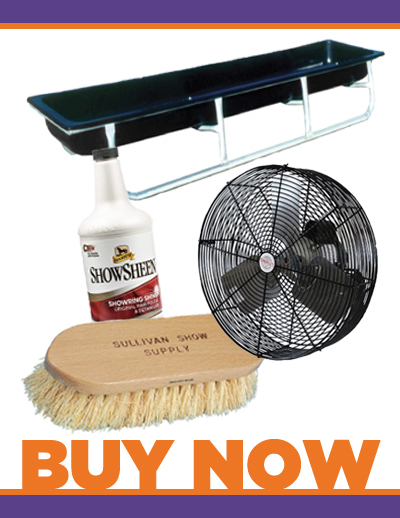
For a complete list of recommended products with buy now links:
